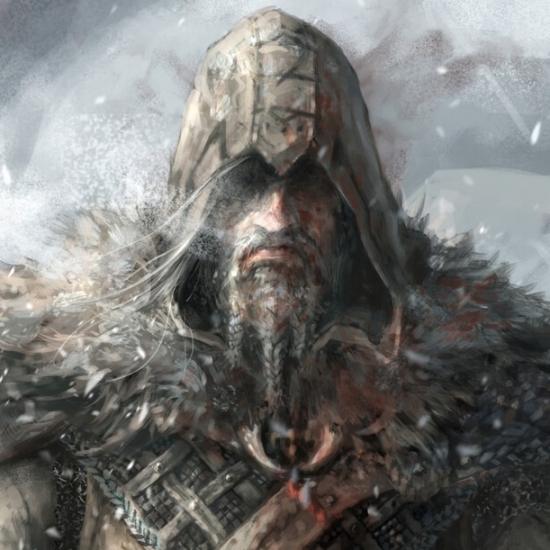GREAT BRITAIN
ENGLAND
The earliest recorded planned Viking raid, on 6 January 793, targeted the monastery on the island of Lindisfarne, off the north-east coast of Northumbria. According to the 12th-century Anglo-Norman chronicler Symeon of Durham, the raiders killed the resident monks or threw them into the sea to drown or carried them away as slaves – along with some of the church treasures. In 875, after enduring eight decades of repeated Viking raids, the monks fled Lindisfarne, carrying the relics of Saint Cuthbert with them.
In 865, a group of hitherto uncoordinated bands of predominantly Danish Vikings joined together to form a large army and landed in East Anglia. The Anglo-Saxon Chronicle described this force as the mycel hæþen here (Great Heathen Army) and went on to say that it was led by Ivar the Boneless and Halfdan Ragnarsson. The army crossed the Midlands into Northumbria and captured York (Jorvik). In 871 the Great Heathen army was reinforced by what was known as the Great Summer Army, one of its leaders was Guthrum. In 875 the Great Heathen Army split into two bands, with Guthrum leading one back to Wessex, and Halfdan taking his followers north. Then in 876, Halfdan shared out Northumbrian land amongst his men, who “ploughed the land and supported themselves”; this land was part of what became known as the Danelaw.
Most of the English kingdoms, being in turmoil, could not stand against the Vikings, but King Alfred of Wessex defeated Guthrum’s army at the Battle of Edington in 878. There followed the Treaty of Wedmore the same year and the Treaty of Alfred and Guthrum in 886. These treaties formalized the boundaries of the English kingdoms and the Viking Danelaw territory, with provisions for peaceful relations between the English and the Vikings. Despite these treaties, conflict continued on and off. However, Alfred and his successors eventually drove back the Viking frontier and retook York.
A new wave of Vikings appeared in England in 947, when Erik Bloodaxe captured York. The Viking presence continued through the reign of the Danish prince Cnut the Great (reigned as King of England: 1016–1035), after which a series of inheritance arguments weakened the hold on power of Cnut’s heirs.
SCOTLAND
The monastery at Iona on the west coast was first raided in 794, and had to be abandoned some fifty years later after several devastating attacks. While there are few records from the earliest period, it is believed that Scandinavian presence in Scotland increased in the 830s. The isles to the north and west of Scotland were heavily colonised by Norwegian Vikings. Shetland, Orkney and the Hebrides came under Norse control, sometimes as fiefs under the King of Norway, and at other times as separate entities under variously the Kings of the Isles, the Earldom of Orkney and the later Kings of Mann and the Isles. Shetland and Orkney were the last of these to be incorporated into Scotland in as late as 1468.
WALES
Wales was not colonized by the Vikings significantly as in eastern England. The Vikings did, however, settle in small numbers in the south around St Davids, Haverfordwest, and the Gower. Place names such as Skokholm, Skomer, and Swansea remain as evidence of the Norse settlement. The Vikings, however, were not able to set up a Viking state or control Wales, owing to the powerful forces of Welsh kings, and, unlike in Scotland, the aristocracy was relatively unharmed. Nevertheless, following the successful Viking alliance with Britanny in 865, the Britons made their peace with the Danes, and a Viking/Welsh alliance in 878 defeated an Anglo-Saxon army from Mercia. Although the Welsh had been longtime enemies of the Anglo-Saxon kingdom of Mercia, their relationship with the Anglo-Saxon kingdom of Wessex was somewhat warmer. The Anglo-Saxon Chronicle of 893, for example, refers to Vikings being pursued by a combined force of West Saxons and north Welsh along the River Severn.
The combined Anglo-Saxon and Welsh army eventually overtook the Vikings before defeating them at the Battle of Buttington.
The city of Swansea was founded by Sweyn Forkbeard, King of Denmark, who by 1013 was King of the Danes, Anglo-Saxons and Norwegians. The English name for the town derives from Old Norse: Sveinsey, meaning either “Sweyn’s island” or “Sweyn’s inlet” (see Swansea). The neighboring Gower Peninsula has some place names of Norse origin. For example, Worm’s Head is from Old Norse: ormr, the word for snake or dragon, as the Vikings believed that the serpent-shaped island was a sleeping dragon. Some twenty miles (32 kilometres) west of Cardiff on the Vale of Glamorgan coast is the semi-flooded island of Tusker Rock, which takes its name from Tuska, the Viking who established a settlement in the area.
CORNWALL
The Anglo-Saxon Chronicle reported that heathen men (the Danes) raided Charmouth, Dorset in 833 AD, then in 997 AD they destroyed the Dartmoor town of Lydford, and from 1001 AD to 1003 AD they occupied the old Roman city of Exeter.
The Cornish were subjugated by King Æthelstan, of England, in 936 and the border finally set at the River Tamar. However, the Cornish remained semi-autonomous until their annexation into England after the Norman Conquest.
IRELAND
The Vikings conducted extensive raids in Ireland and founded many towns, including Dublin, Limerick, Wexford, Waterford, Wicklow, Arklow and Leixlip. Literature, crafts, and decorative styles in Ireland and Britain reflected Scandinavian culture. Vikings traded at Irish markets in Dublin. Excavations found imported fabrics from England, Byzantium, Persia, and central Asia. Dublin became so crowded by the 11th century that houses were built outside the town walls. The Vikings pillaged monasteries on Ireland’s west coast in 795, and then spread out to cover the rest of the coastline. The north and east of the island were most affected. During the first 40 years, the raids were conducted by small, mobile Viking groups. From 830 on, the groups consisted of large fleets of Viking ships. From 840, the Vikings began establishing permanent bases at the coasts. Dublin was the most significant settlement in the long term. The Irish became accustomed to the Viking presence and culture. In some cases they became allies and also intermarried.
The Annals of Ulster states that in 821 the Vikings plundered an Irish village and “carried off a great number of women into captivity”.
In 832, a Viking fleet of about 120 ships under Turgesius invaded kingdoms on Ireland’s northern and eastern coasts. Some believe that the increased number of invaders coincided with Scandinavian leaders’ desires to control the profitable raids on the western shores of Ireland. During the mid-830s, raids began to push deeper into Ireland. Navigable waterways made this deeper penetration possible. After 840, the Vikings had several bases in strategic locations throughout Ireland.
In 838, a small Viking fleet entered the River Liffey in eastern Ireland, probably led by the chieftain Saxolb (Soxulfr) who was killed later that year. The Vikings set up a base, which the Irish called longphorts. This longphort would eventually become Dublin. After this interaction, the Irish experienced Viking forces for about 40 years. The Vikings also established longphorts in Cork, Limerick, Waterford, and Wexford. The Vikings were driven out of Ireland for a short period in 902, but returned to Waterford in 914 to found what would become Ireland’s first city. The other longphorts were soon re-occupied and developed into cities and towns.
The last major Irish battle involving Vikings was the Battle of Clontarf in 1014, in which a large force from the pan-Viking world and their Irish allies opposed Brian Boru, then the High King of Ireland and his forces, a small contingent of which were Viking defectors. After the battle, Viking power was broken in Ireland forever, though many settled Norse remained in the cities and prospered greatly with the Irish through trade. With Brian dead, Ireland returned to the fractured kingdom it had once been, but was now cleared of further Viking predation.
ARABIA
ISLAMIC LEVANT: The well-known Harald Hardrada would also serve the Byzantine emperor in Palestine as well as raiding North Africa, the Middle East as far east as Armenia, and the island of Sicily in the 11th century, as recounted in his saga in Snorri Sturluson’s Heimskringla. Evidence for Norse ventures into Arabia and Central Asia can be found in runestones erected in Scandinavia by the relatives of fallen Viking adventurers. Several of these refer to men who died in “Serkland” (possibly Arabia).
Meanwhile, in the Eastern Mediterranean the Norse (referred to as Rus’) were viewed more as “merchant-warriors” who were primarily associated with trade and business. Indeed, one of the only detailed accounts of a Viking burial come from Ibn-Fadlan’s account. At times this trading relationship would break down into violence – Rus’ armadas raided in the Caspian on at least three occasions, in 910, 912 and 943.
The 10th century Arab-Muslim traveller Ahmad Ibn Fadlan recorded his meeting more than 1,000 years ago with a strange race he called the “Rusiyyah”, now commonly known as Vikings.
A substantial portion of Ibn Fadlan’s account is dedicated to the description of a people he called the Rūs (روس) or Rūsiyyah. Western scholarship has generally assumed that he was describing Volga Vikings, the North Germanic tribes travelling the Volga trade route, though the identification of the people Ibn Fadlān describes is uncertain. The Rūs appear as traders who set up shop on the river banks nearby the Bolğar camp. They are described as having bodies tall as (date) palm-trees, with blond hair and ruddy skin. Each is tattooed from “the tips of his toes to his neck” with dark blue or dark green “designs” and all men are armed with an axe, sword and long knife.
Ibn Fadlan describes the Rus as “perfect” physical specimens and the hygiene of the Rūsiyyah as disgusting and shameless, especially regarding to sex (which they perform openly even in groups), and considers them vulgar and unsophisticated. In that, his account contrasts with that of the Persian traveler Ibn Rustah, whose impressions of the Rus were more favourable, although it has been attributed to a possibly intentional mistranslation with the original texts being more in line with Ibn Fadlan’s narrative. He also describes in great detail the funeral of one of their chieftains (a ship burial involving rape and human sacrifice). Some scholars believe that it took place in the modern Balymer complex.
“I have never seen bodies as nearly perfect as theirs. As tall as palm trees, fair and reddish, they wear neither tunics nor kaftans. Every man wears a cloak with which he covers half of his body, so that one arm is uncovered. They carry axes, swords, daggers and always have them to hand. They use Frankish swords with broad, ridged blades.”
Ibn Fadlan recorded his meeting more than 1,000 years ago with a strange race he called the “Rusiyyah”, now commonly known as Vikings. He first met the Norse warriors as they travelled across the Russian steppes, sailing their longships down the Volga river and looking to trade with the Arab world, he stated “there were women as well, who each wore “a small box made of iron, silver, brass or gold, depending on her husband’s financial worth and social standing, tied at her breasts. The box has a ring to which a knife is attached, also tied at her breasts.” He also added: “The women wear neck rings of gold and silver. When a man has amassed 10,000 dirhams, he has a neck ring made for his wife. When he has amassed 20,000 dirhams, he has two neck rings made. For every subsequent 10,000 dirhams, he gives a neck ring to his wife. This means a woman can wear many neck rings.”
Among the Arabs who encountered Vikings, the reaction was a mixture of horror and fascination. The knife worn by the women may have actually been a scoop for ear wax. The men were tattooed and performed brutal burial rituals that included killing slaves. The Arabs might have been largely unimpressed with the Vikings, but they made a big impression on the Norsemen, new archaeological discoveries show.
Written sources speak of Viking and Arabic travellers visiting each other, and finding physical objects of Islamic origin in Viking Age Sweden at least partly verifies these written accounts. A rare ring with an inscription in Arabic has been uncovered at a Scandinavian site, this discover has added credence to the ancient accounts of Arab travellers in their encounters with the Norsemen, and points to a fascinating trade and cultural exchange. It is the only ring of this type ever found. The non-gilded silver alloy ring was found in a 9th century woman’s grave at the Viking trading centre in Birka, Sweden. It is set with a violet stone inscribed with Arabic Kufic writing, interpreted as reading “il-la-lah” (for “or to Allah”). The ring went straight from the Caliphate to Sweden. Silver dirham coins have also been found in Viking-era archaeological sites, but the wear on the coins showed they had travelled far and wide. The research paper on the Birka ring concludes that it is not impossible that the woman herself, or someone close to her, might have visited – or even originated from – the Caliphate or its surrounding regions.
The angular script was developed in the 7th century, dominated Arabic writing in the 8th to 10th centuries and waned in popularity during the 12th century when it was replaced by the cursive Naskh style. The ring is not the first evidence of its kind regarding links between Vikings and the Muslim world, but “is arguably so far the best evidence for direct contacts”.
The relationship was primarily one of trade. The Vikings were obsessed with silver dirhams coined in Muslim lands. They traded weapons, furs and slaves for money. There is little evidence of cultural exchange. Occasionally a group of Vikings is described as raiding the lands they visited, although the sources that describe them as peaceful in their dealings with the Muslims outnumber those that describe them as violent.
More is supposed by archaeological evidence, such as the ring and other finds including Arabic weighing scales, beads, vessels, censers (incense burners) and over a quarter of a million Islamic silver coins – “are evidence of a cultural exchange.
Contacts between Vikings and Arabs/Muslims were both peaceful and violent. Since most of the contacts took place via trade, the relationship was mostly peaceful, but we also have accounts of Viking raids in the Caspian Sea which resemble accounts we have from Europe in a similar period, according to Prof Hraundal Jonsson. The Vikings took goods such as honey, furs, iron, amber and slaves from the Baltic region to the Caliphate.
In the Scandinavian research tradition, there is a tendency to focus on the Scandinavian transition from Viking Age paganism to Christian Catholicism. Contacts with other religions, such as Orthodox Christianity, Judaism, and Islam, has largely been neglected. But such contacts must have taken place, and most likely influenced the Viking culture. Objects of Islamic origin tell us that the Vikings must have been aware of many other cultures and belief systems, said Professor Warmlander. While the Arabs generally regarded the Vikings as barbaric, there is still much to discover. Ibn Fadlan’s account gives a peek into what the Vikings thought of their visitors. The connection between the Vikings and Arab Muslims has long been neglected. One exception was the Hollywood film The 13th Warrior made in 1999, with Antonio Banderas as Ahmad Ibn Fadlan, a fictional character based on the real-life traveller. A mysterious character, the real Ibn Fadlan was a key member of a diplomatic mission sent by Abbasid Caliph Al Muqtadir in 921 from Baghdad to the upper reaches of the river Volga, in answer to a request for diplomatic assistance from the king of Volga Bulgaria. The king had recently converted to Islam and needed help in training jurists, instructing his people in how to pray properly, and in financial assistance to build a mosque and a fort. Visitors to this year’s Abu Dhabi International Book Fair, which runs from today until Wednesday, will be able to discover more about Ibn Fadlan and the story of Vikings and the Arabs.
NORTH AMERICA
Roughly 1,000 years ago, Viking trader and adventurer named Thorfinn Karlsefni set off from the west coast of Greenland with three ships and a band of Norse to explore a newly discovered land that promised fabulous riches. Following the route that had been pioneered some seven years before by Leif Eriksson, Thorfinn sailed up Greenland’s coast, traversed the Davis Strait and turned south past Baffin Island to Newfoundland—and perhaps beyond. Snorri, the son of Thorfinn and his wife, Gudrid, is thought to be the first European baby born in North America.
Thorfinn and his band found their promised riches—game, fish, timber and pasture—and also encountered Native Americans. Their relations with the Natives steadily deteriorated, due to how the referenced them as “wretched people”. Approximately three years later, Thorfinn—along with his family and surviving crew—abandoned the North American settlement, perhaps in a hail of arrows, as Archaeologists have found arrowheads with the remains of buried Norse explorers in the region. Afterwards, they sailed back to Greenland and then Norway, Thorfinn and his family settled in Iceland, Thorfinn’s childhood home.
The Norse colonization of North America began in the late 10th century AD when Norsemen explored and settled areas of the North Atlantic including the northeastern fringes of North America. Remains of Norse buildings were found at L’Anse aux Meadows near the northern tip of Newfoundland in 1960. This discovery aided the reignition of archaeological exploration for the Norse in the North Atlantic.
The Norse settlements in the North American island of Greenland lasted for almost 500 years. L’Anse aux Meadows, the only confirmed Norse site in present-day Canada, was small and did not last as long. While voyages, for example to collect timber, are likely to have occurred for some time, there is no evidence of any lasting Norse settlements on mainland North America.
According to the Icelandic sagas—Eirik the Red’s Saga, Saga of the Greenlanders, plus chapters of the Hauksbók and the Flatey Book—the Norse started to explore lands to the west of Greenland only a few years after the Greenland settlements were established. In 985, while sailing from Iceland to Greenland with a migration fleet consisting of 400–700 settlers and 25 other ships (14 of which completed the journey), a merchant named Bjarni Herjólfsson was blown off course, and after three days’ sailing he sighted land west of the fleet. Bjarni was only interested in finding his father’s farm, but he described his discovery to Leif Erikson who explored the area in more detail and planted a small settlement fifteen years later.
EUROPE
In the 9th and 10th centuries, the Vikings raided the largely defenceless Frisian and Frankish towns lying on the coast and along the rivers of the Low Countries. Although Vikings never settled in large numbers in those areas, they did set up long-term bases and were even acknowledged as lords in a few cases. They set up bases in Saint-Florent-le-Vieil at the mouth of the Loire, in Taillebourg on the mid Charente, also around Bayonne on the banks of the Adour, in Noirmoutier and obviously on the River Seine (Rouen) in what would become Normandy. In fact, the name Normandy itself denotes the Viking origin. After their settlement when it became known as “Northmannia” or Land of The Norsemen.
Antwerp was raided in 836. Later there were raids of Ghent, Kortrijk, Tournai, Leuven and the areas around the Meuse river, the Rhine, the Rupel river and the tributaries of those rivers. Raids were conducted from bases established in Asselt, Walcheren, Wieringen and Elterberg (or Eltenberg, a small hill near Elten). In Dutch and Frisian historical tradition, the trading centre of Dorestad declined after Viking raids from 834 to 863; however, since no convincing Viking archaeological evidence has been found at the site (as of 2007), doubts about this have grown in recent years.
One of the most important Viking families in the Low Countries was that of Rorik of Dorestad (based in Wieringen) and his brother Harald (based in Walcheren). Around 850, Lothair I acknowledged Rorik as ruler of most of Friesland. And again in 870 Rorik was received by Charles the Bald in Nijmegen, to whom he became a vassal. Viking raids continued during this period. Harald’s son Rodulf and his men were killed by the people of Oostergo in 873. Rorik died sometime before 882.
Buried Viking treasures consisting mainly of silver have been found in the Low Countries. Two such treasures have been found in Wieringen. A large treasure found in Wieringen in 1996 dates from around 850 and is thought perhaps to have been connected to Rorik. The burial of such a valuable treasure is seen as an indication that there was a permanent settlement in Wieringen.
Around 879, Godfrid arrived in Frisian lands as the head of a large force that terrorised the Low Countries. Using Ghent as his base, they ravaged Ghent, Maastricht, Liège, Stavelot, Prüm, Cologne, and Koblenz. Controlling most of Frisia between 882 and his death in 885, Godfrid became known to history as Godfrid, Duke of Frisia. His lordship over Frisia was acknowledged by Charles the Fat, to whom he became a vassal. In the siege of Asselt in 882, the Franks sieged a Viking camp at Asselt in Frisia. Although the Vikings were not forced by arms to abandon their camp, they were compelled to come to terms in which their leader, Godfrid, was converted to Christianity. Godfrid was assassinated in 885, after which Gerolf of Holland assumed lordship and Viking rule of Frisia came to an end.
Viking raids of the Low Countries continued for over a century. Remains of Viking attacks dating from 880 to 890 have been found in Zutphen and Deventer. The last attacks took place in Tiel in 1006 and Utrecht in 1007.
ITALY: Around 860, Ermentarius of Noirmoutier and the Annals of St-Bertin provide contemporary evidence for Vikings based in Frankia proceeding to Iberia and thence to Italy.
Three or four eleventh-century Swedish Runestones mention Italy, memorialising warriors who died in ‘Langbarðaland’, the Old Norse name for southern Italy (Langobardia Minor). It seems clear that rather than being Normans, these men were Varangian mercenaries fighting for Byzantium. Varangians may first have been deployed as mercenaries in Italy against the Arabs as early as 936.
Contact between Sweden and what is now Finland was considerable even during pre-Christian times; the Vikings were known to the Finns due to their participation in both commerce and plundering. There is possible evidence of Viking settlement in the Finnish mainland. The Åland Islands probably had Swedish settlement during the Viking Period. However, some scholars claim that the archipelago was deserted during the 11th century. According to the archaeological finds, Christianity gained a foothold in Finland during the 11th century. According to the very few written documents that have survived, the church in Finland was still in its early development in the 12th century. Later medieval legends from late 13th century describe Swedish attempts to conquer and Christianize Finland sometime in the mid-1150s.
REST OF THE WORLD
THE IBERIAN PENINSULA
Compared with the rest of Western Europe, the Iberian Peninsula seems to have been little affected by Viking activity, either in the Christian north or the Muslim south. In some of their raids on Iberia, the Vikings were crushed either by the Kingdom of Asturias or the Emirate armies.
Our knowledge of Vikings in Iberia is mainly based on written accounts, many of which are much later than the events they purport to describe, and often also ambiguous about the origins or ethnicity of the raiders they mention. A little possible archaeological evidence has come to light, but research in this area is ongoing. Viking activity in the Iberian peninsula seems to have begun around the mid-ninth century as an extension of their raids on and establishment of bases in Frankia in the earlier ninth century, but although Vikings may have over-wintered there, there is as yet no evidence for trading or settlement.
EASTERN EUROPE
The Vikings settled coastal areas along the Baltic Sea, and along inland rivers in Russian territories such as Staraya Ladoga, Novgorod and along major waterways to the Byzantine Empire.
The Varangians or Varyags (Russian, Ukrainian: Варяги, Varyagi) sometimes referred to as Variagians were Scandinavians who migrated eastwards and southwards through what is now Russia, Belarus and Ukraine mainly in the 9th and 10th centuries. Engaging in trade, colonization, piracy and mercenary activities, they roamed the river systems and portages of Garðaríki, reaching and settling at the Caspian Sea and in Constantinople.
ICELAND
Iceland was first settled around 870. The first permanent settler in Iceland is usually considered to have been a Norwegian chieftain named Ingólfr Arnarson. According to the story, he threw two carved pillars overboard as he neared land, vowing to settle wherever they landed. He then sailed along the coast until the pillars were found in the southwestern peninsula, now known as Reykjanesskagi. There he settled with his family around 874, in a place he named Reykjavík (Bay of Smokes) due to the geothermal steam rising from the earth. It is recognized, however, that Ingólfur Arnarson may not have been the first one to settle permanently in Iceland – that may have been Náttfari, a slave of Garðar Svavarsson who stayed behind when his master returned to Scandinavia.
GREENLAND
In the year 985, Erik the Red was believed to have discovered Greenland after being exiled from Iceland for murder in 982. Three years later in 986, Erik the Red returned with 14 surviving ships (as 25 set out on the expedition).Two areas along Greenland’s southwest coast were colonized by Norse settlers, including Erik the Red, around 986.
SVALBARD
Vikings may have discovered Svalbard as early as the 12th century. Traditional Norse accounts exist of a land known as Svalbarð – literally “cold shores”. (But this land might also have been Jan Mayen, or a part of eastern Greenland.) The Dutchman Willem Barents made the first indisputable discovery of Svalbard in 1596.
NOTES / REFERENCES
Not all the Norse arriving in Ireland and Great Britain came as raiders. Many arrived with families and livestock, often in the wake of the capture of territory by their forces. The populations then merged over time by intermarriage into the Anglo-Saxon population of these areas. Many words in the English language come from old Scandinavian languages.
This article was derived from the information provided by various sources, including the Wikipedia pages of the topics of Viking Expansion, the history Scandinavia, Finland, North America and the Travels of Ahmed Ibn Fadlan.
 RINO THE BOUNCERPharmacist. Visual Artist. Ubisoft Star Player, Assassin's Creed Brand Ambassador, Founder and Community Leader of The Codex. Tomb Raider Localization Ambassador and Official Fansite Founder.NEWS FEEDTestimonial"Just stumbled across this site after looking at some topics on the Ubisoft Forums, this is great! Exactly the thing I was looking for.""Your site lays everything down in an interesting and easy to read format, even I learn new things whilst reading your articles!""This needs more than just 5 stars!""There is only one word AMAZING!!!!!!! GREAT WORK.""Very in depth and very well thought out! Keep up the good work!"One of the best (if not the best one) AC community pages out there. Keep up the good work!
RINO THE BOUNCERPharmacist. Visual Artist. Ubisoft Star Player, Assassin's Creed Brand Ambassador, Founder and Community Leader of The Codex. Tomb Raider Localization Ambassador and Official Fansite Founder.NEWS FEEDTestimonial"Just stumbled across this site after looking at some topics on the Ubisoft Forums, this is great! Exactly the thing I was looking for.""Your site lays everything down in an interesting and easy to read format, even I learn new things whilst reading your articles!""This needs more than just 5 stars!""There is only one word AMAZING!!!!!!! GREAT WORK.""Very in depth and very well thought out! Keep up the good work!"One of the best (if not the best one) AC community pages out there. Keep up the good work!





